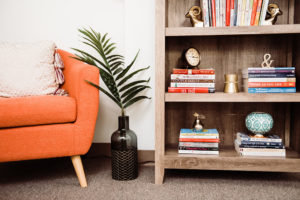Are you ready to go back to “normal”?
As we head into the summer months, we find ourselves living in a unique state of limbo as a society. We are not quite through the COVID-19 health scare, yet the crisis part seems to have passed. Plans are being unveiled to re-open cities, which might feel like both a blessing and a curse at the same time. As offices, restaurants, shopping malls, hair salons, and gyms begin to re-open, we are all left to ponder what our own personal transition back into society will look like.
When we talk about re-opening things, we’re not talking about “going back to normal life.” We’re actually talking about a new normal, and nobody really knows quite what that will look like in the long run. This uncertainty, coupled with the fact that we’ve all been living in relative isolation for several months, might have you feeling anxious or worried (surprise!).
As more aspects of our communities come back to life, each of us will be faced with questions about our transition: When will I feel comfortable going to my favorite restaurant for indoor dining? Why are others ready to have in-person get-togethers but I don’t think it’s a good idea? What do I do when my office building re-opens but I don’t want to return yet?
How we navigate our own transition will be based on our personal comfort level with the general safety precautions that are occurring out in the “real world”. But, we might also find ourselves having “all the feels” about re-acclimating to the social expectations that will return once things “open up” again.
At Lincoln Park Therapy Group, we understand that the transition to this new reality might spark some uncomfortable feelings for some people in our community so we’ve put together these helpful tips to help you deal with any anxiety, worry, or sadness you might have about it.
Start Slowly
Just because everything is opening back up doesn’t mean you have to jump right in. It’s perfectly fine to take your time readjusting to things. This will be a transition, and some people will need more time than others to feel comfortable resuming “normal” activities like shopping for fun, going to happy hours, or hitting the gym. That’s okay. Don’t push yourself too quickly, but consider gently challenging yourself to expand your comfort zone. This might look like:
- going to the grocery store during peak hours and buying a couple of items, rather than going when it’s less crowded
- meeting up with a couple of friends who have been practicing the same safety precautions you have
- spending time outdoors in popular areas to practice social distancing
- stopping by your favorite restaurant and going inside to order for take-out, rather than getting it delivered
Of course, we encourage everybody to continue practicing all recommended safety measures while engaging in these activities.
Have a Process
You don’t have to go about this transition on a whim. You can be thoughtful, intentional, and strategic about it. Try creating a plan for yourself to follow as you transition back into your old routine. That might include things like:
- having extra masks for your purse, car, and gym bag
- stocking up on hand sanitizer for the desk in your office
- calling places to ask what safety precautions they are following before visiting
- asking people to wash or sanitize their hands before coming into your home
- telling your friends you’ll only go to outdoor dining restaurants for now
- putting a sign on your office door reminding people that you’re following the 6 ft. social distancing recommendations
- create some “non-negotiables” for yourself, like limiting the number of people you’ll meet with for a social activity, or setting a maximum number of outings you’ll do a week
Having a plan to follow can do a lot to ease anxiety. It helps you feel more in control (which is especially helpful when there are so many things out of our control). It can also help you with decision-fatigue when you follow your non-negotiables. You won’t have to worry about deciding yes or no – just look at the “rules” you set for yourself and assess whether a situation meets them or not.
Test It Out
As you think about your next steps, try not to make assumptions. You might worry that people are completely disregarding safety measures, but that might not be the case. Give yourself permission to explore – stop by a store you’ve been longing to visit and see how it feels to be there. If you feel okay, stay and browse a bit. If you don’t feel safe or if your anxiety increases, it’s okay to leave. As much as you might be tempted to stay inside and isolate, it can be helpful to see that it’s not that scary out there. In our experience, most people are social distancing and practicing other safety measures to keep themselves and their neighbors safe. And if you’re out and about and you run into people who aren’t practicing safety measures, it’s okay to avoid them.
Keep What You Love
Some people have found that they’ve enjoyed the respite they’ve experienced in taking a break from the daily grind. Maybe you’ve picked up a new hobby, like gardening or baking (seriously, have you heard about all the people baking sourdough bread?). Or, perhaps you’ve rediscovered your love of reading or doing puzzles. The shelter-in-place orders gave us a one-in-a-lifetime experience of hunkering down for weeks on end, and some people are reluctant to let that go. The good news is… you don’t have to. You can carry whatever hobby, activity, or way of being that you discovered during that time into this new reality. Just because the world is opening up again doesn’t mean you have to give up the personal activities you’ve grown to love.
What people don’t realize is that the uncertainty of a situation is often more anxiety-provoking than the worst-case-scenario. Especially with this new normal that has yet to be unveiled, you might find yourself worked up over situations that will never happen. Though it’s okay to be cautious, don’t let your fear or anxiety have too much power. You’ll find that you’ll miss out on the things you used to love and the cost to your own sense of joie de vivre will be too much.
We know that these are difficult times, and we’re here to help our Chicago community however we can. If you find that you’re struggling with increased anxiety or fear right now, please schedule a time to meet with one of our therapists. We’re here for you and we’d love to meet with you.

 Nicolle Osequeda, LMFT, is the founder of Lincoln Park Therapy Group, specializing in anxiety, depression, and relationship counseling in Chicago. As a Certified Daring Way™ Facilitator, she incorporates Dr. Brené Brown’s research into her therapy. Nicolle holds a Master’s in Counseling Psychology from the University of San Francisco and is a Licensed Marriage & Family Therapist in Illinois and California. She is a Clinical Fellow of AAMFT, a member of IAMFT, and the Financial Therapy Association. Nicolle has Gottman Method training and has taught at DePaul University, dedicated to helping individuals and couples achieve meaningful change.
Nicolle Osequeda, LMFT, is the founder of Lincoln Park Therapy Group, specializing in anxiety, depression, and relationship counseling in Chicago. As a Certified Daring Way™ Facilitator, she incorporates Dr. Brené Brown’s research into her therapy. Nicolle holds a Master’s in Counseling Psychology from the University of San Francisco and is a Licensed Marriage & Family Therapist in Illinois and California. She is a Clinical Fellow of AAMFT, a member of IAMFT, and the Financial Therapy Association. Nicolle has Gottman Method training and has taught at DePaul University, dedicated to helping individuals and couples achieve meaningful change. 

